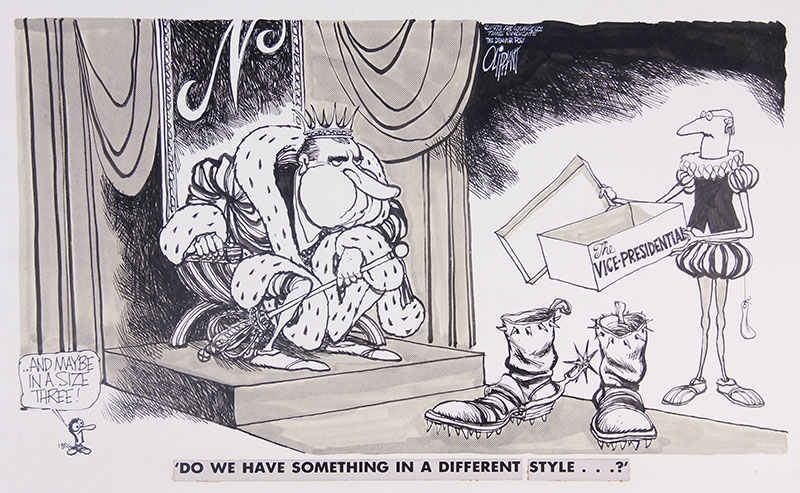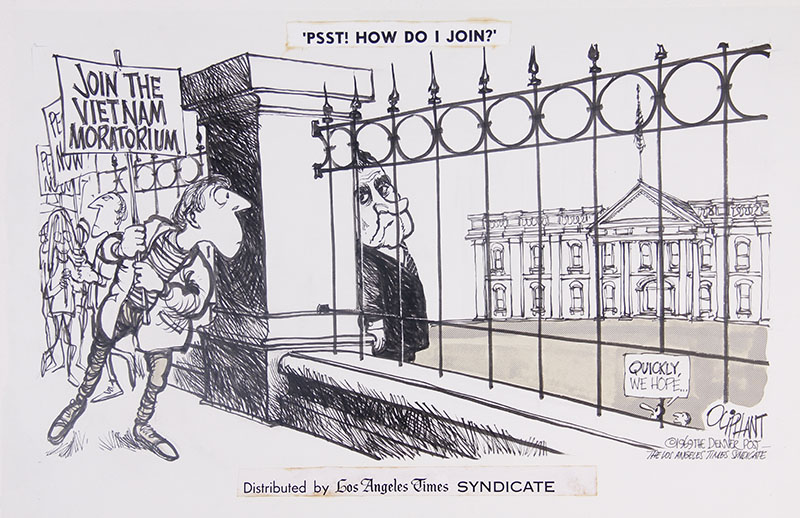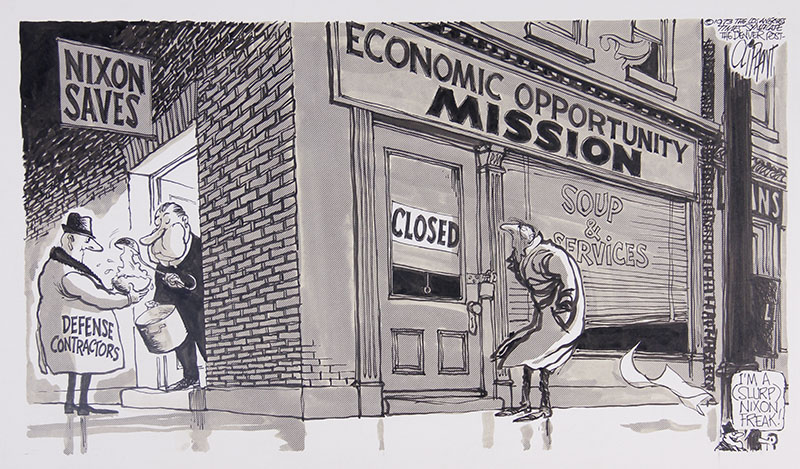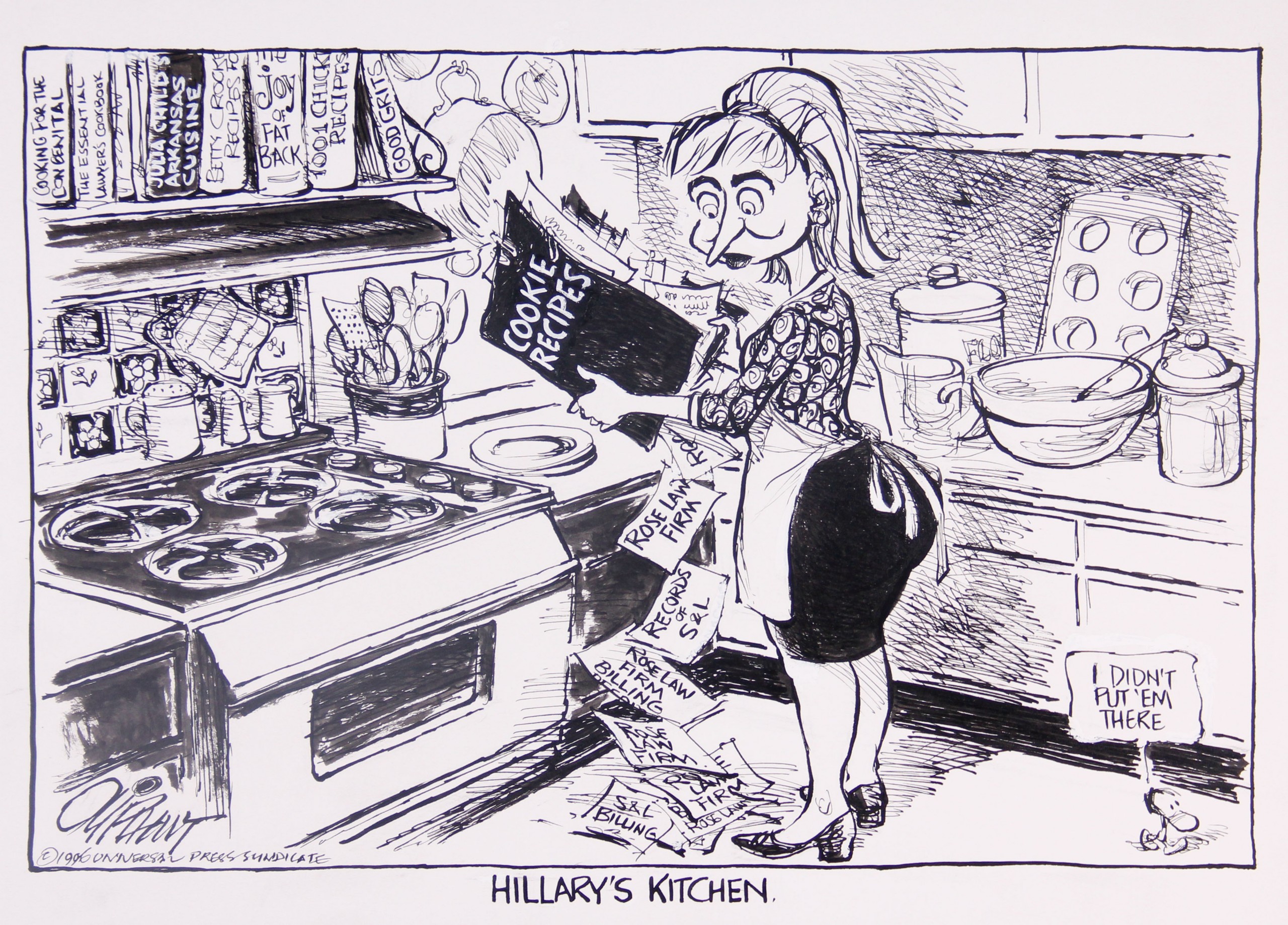Pat Oliphant: Editorial Cartoons from the Nixon and Clinton Eras
February 4 through May 31, 2021
Pulitzer Prize winning cartoonist Patrick Oliphant was described in 1990 by the New York Times as “the most influential editorial cartoonist” of his time. Spanning more than sixty years, Oliphant’s finely-tuned drawings have cast a clear eye on global politics, culture, the economy, and scandals, and his caricatures of American presidents and other powerful leaders are world renowned. In addition to thousands of daily editorial cartoons, he has also produced personal works, including dozens of bronze sculptures, works on paper, and paintings.
This important collection of original works by Oliphant has been generously donated by the Louis and Jodi Atkin Family, devoted collectors who compiled the largest and most significant body of the artist’s work in private hands. The Oliphant collection features three prominent aspects of the artist’s work⸺his editorial drawings from the Nixon and Clinton years as well as personal drawings, paintings, and sculptures. The donor intends this collection to serve as a means of highlighting political art as a powerful, persuasive, and inspiring form of visual communication. In addition, the collection invites consideration of the role of political illustration in inspiring dialogue, which is of critical importance today as in the past. We are honored to showcase the work of this exceptional illustration master and to preserve and share this important collection for generations to come.
Oliphant’s Satirical Portraits
Since the late nineteenth century, the editorial cartoon has played a provocative role in presidential politics, countering partisan advertising with irreverence. Australian-born Pulitzer Prize winner Pat Oliphant (born 1935) hones a distinctive, repeatable caricature of each incoming president. When each fails to live up to expectations, those exaggerated figures begin to age, sag, shrink, weaken, or bloat. Oliphant has summarized his cartoon depictions of each president since Lyndon Johnson in a series of bronze sculptures. His images of Richard Nixon as a haunting and malevolent Napoleon, Gerald Ford as Band-Aided hollow mask, Jimmy Carter as an insignificant miniature, and George H. W. Bush as a wizened horseshoe player, remind us of the powerful impact of satiric portraiture.
About the Patrick Oliphant
Born on July 24, 1935, Patrick Oliphant was raised in a small cabin outside of Adelaide, Australia; he attended a one-room schoolhouse and went on to complete his formal education at a local high school. His interest in drawing was sparked by his father’s work as a government draftsman and he decided at an early age that he wanted to become a journalist. Uninterested in pursuing higher education and still a teenager, in 1952 he began working as a copyboy for Adelaide’s evening newspaper, The News, which had recently been inherited by a young Rupert Murdoch. The following year, Oliphant moved to a rival publication, The Advertiser, where he worked as a press artist, and by 1955 he was drawing editorial cartoons.
Frustrated by The Advertiser’s conservative editorial policies, Oliphant had his eyes set on working in the United States. Upon completion of a five-year commitment to the publication, he landed a job with the Denver Post after submitting an exceptional portfolio that singled him out over fifty other applicants. Within a year of joining the Post, his work was disseminated internationally by the Los Angeles Times Syndicate. Oliphant’s reputation grew quickly and in 1967 he was awarded the Pulitzer Prize.
In 1975, Oliphant moved to the Washington Star and five years later switched to Universal Press Syndicate. When the Star went out of business in 1981, he decided to remain independent, thus becoming the first political cartoonist in the twentieth century from a home-town newspaper to to work independently. By 1983 Oliphant was the most widely syndicated American cartoonist, with works appearing in more than five hundred publications. In addition to the Pulitzer Prize, Oliphant has been recognized with numerous awards from the Society of Professional Journalists, National Cartoonists Society, National Wildlife Federation, American Civil Liberties Union, and the Washington Journalism Review. He retired from an active illustration career in 2015 due to challenges with his eyesight.








